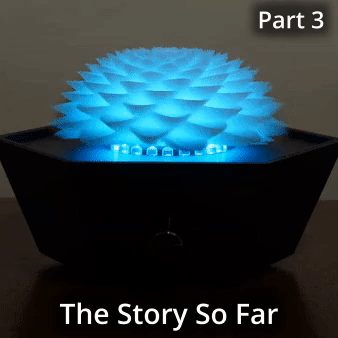
The Story So Far: Part 3/3
April 07, 2021
Brandon Keeber
With video of the MegaTrope spreading among friends and family, we got some very helpful feedback.
- Multi-color control is better than pure white light (by a mile).
- Internally lit looks better than overhead lit.
- Cutting off the sphere at 3/4 height rather than half resulted in a more interesting sculpture.

We also learned from designing and executing the build that there's significantly less complexity involved since we no longer needed to build the infrastructure to suspend a light from overhead. Now I'd like to take a moment to recap the issues with the Pagoda model, namely that it was overly-complex, too costly to produce, color-limited, and a bit too stylized to appeal to a large audience.
The MegaTrope was obviously too large, complex, and expensive to make it accessible to the average citizen. But all of the lessons learned from building it inspired in us a product that could solve all of the problems present in the Pagoda.
Enter, the "GlowaTrope" (we later changed this name at the behest of our more marketing-savvy team members). The goal was to miniaturize the MegaTrope, making it simple enough to mass-produce, and cheap enough for the average person to purchase. We put together a number of prototypes for the base station, soldered some RGB LEDs into it, built a modified lower-voltage MegaTrope circuit, and spun it up.


Of the UFO, Cuboid, and Hex base protoypes visible above, we ended up going with the hexagonal shape, for a number of reasons. First and foremost, it looked the coolest. Design decisions should always be guided by this constraint in my personal opinion. If we're being honest, a cool looking design with less functionality will win out over a more functional, less attractive model 9 times out of 10...at least for the minimum viable prototype. Function always beats form in the long run.
Other, more tangible considerations included manufacturability, functionality, and cost.

As you can see, the LEDs were positioned beneath the sculpture rather than inside of it like on the MegaTrope. We decided that the quick-change nature of the snap-in DVD motor was just too valuable of an asset to abandon, so we added slots at the radius of the LEDs onto the base of the sculptures. and that seemed to allow enough light into the core to provide adequate internal illumination.

Despite this concept validation, the prototype needed a lot of work. Specifically in its manufacturability. RGB LEDs typically have 4 contacts on them; Red, Green, Blue, and either a common anode or common cathod (+ or -). The prototype was built by hand, with all of the common leads soldered to one another in an absolute rats nest configuration, displayed below. It took about 45 minutes to get this right, which is an insane amount of time to spend on a single operation when large quantities come into play.

Two main design changes had to happen to get this product up to snuff; we needed an integrated Printed Circuit Board (PCB) with Surface Mount Device (SMD) LED's, and a smaller form-factor case design, as the first one was unnecessarily tall. Our resident circuits expert and co-founder Jimmy Gomez put together what's called a hybrid board, which includes both SMDs and Thru-Hole devices, and we sent it off to China to get it produced. Obviously this is quite a condensed recounting of events, as the circuit design process is quite iterative and takes a lot of time to get right.
We found a company called JLC PCB which specializes in producing small and large quantity batches of PCBs for extremely cheap, so we iterated and landed on a design with 32 SMD RGB LEDs, with the rest of the components being Thru-Hole devices.

Once we had these boards in-hand, we improvised a quick method to solder SMDs onto the board using some aluminum foil, a kitchen stove-top, and a laser thermometer (more on this quick and dirty SMD soldering method in a later post), and we had our prototypes ready for the thru-hole components which we soldered in using an Amazon soldering iron.

The result was a super-bright, internally-lit miniature version of the MegaTrope, with a small, attractive form-factor. This beautiful little unit was what we'd been working towards the whole time.


With this new platform, we were nearly ready to show it to the world. We began working diligently to prepare for our Kickstarter, for which our goal was to provide the first 100 backers the ability to acquire a NovaTrope dock of their own at cost. The story now switches from a matter of Research and Development to Manufacturing viability and Marketing. Future blog posts will focus on our efforts to establish reliable supplier relations, establish a functional assembly facility, and build up all of the aspects of a successful, enduring business.
If our journey interests you, please help us find a footing in the competitive hardware startup space by following us on social media and showing us to your friends and family. Every like, follow, and share brings us one step closer to being able to get this amazing product into as many people's lives as possible. The hypnotic and thought-provoking effect NovaTropes have on viewers is undeniable, and we think everyone should get a chance to experience that.









